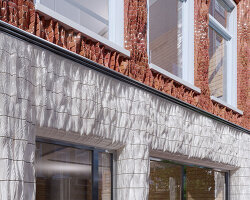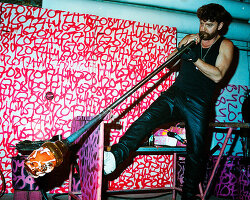designboom visits Studio RAP in Rotterdam
Inside the RDM Innovation Dock in Rotterdam, the Netherlands, Studio RAP is reimagining the boundaries of architecture through a fusion of computational design and digital fabrication. In a workspace filled with robots, prototypes, and intricate models, founders Lucas ter Hall and Wessel van Beerendonk lead a team of architects dedicated to exploring innovative design possibilities. Drawing on influences from natural forms, historical ornamentation, and advanced material experimentation, Studio RAP creates architectural pieces that balance artisanal craftsmanship with cutting-edge robotics. From flowing organic facades to bold interiors and sculptural 3D printed pieces of furniture, their work reflects a forward-thinking approach to design, merging storytelling, technology, and sustainability. ‘In every project, we want to tell a story with different kinds of ingredients,’ Lucas ter Hall shares with designboom. To uncover the origins of Studio RAP, their design philosophy, and what lies ahead, designboom visited the Rotterdam-based studio, and spoke to with Lucas ter Hall. Read on to discover the story of the Dutch multidisciplinary practice.

Studio RAP can be found inside the RDM Innovation Dock in Rotterdam | image © designboom
Exploring the Future of Design Through Craft and Robotics
Studio RAP operates at the crossroads of progress and tradition, where advanced technologies like computational design, robotic fabrication, and 3D printing are integrated into their architectural practice. Their multidisciplinary team—comprising architects, programmers, roboticists, and researchers—takes a hands-on approach to exploring new ways of designing and constructing the built environment. This ethos is vividly demonstrated in the Ceramic House (see designboom’s coverage here), a project that transforms architectural surfaces into a canvas for creativity. By combining bespoke 3D printed ceramic tiles with algorithmic design and artisanal glazing, the Dutch studio crafted a facade that adds a modern yet textural narrative to a historic shopping street. Inspired by the intricacies of knitting, the tiles weave tradition and technology into an entirely new architectural language. Another standout project, New Delft Blue (see designboom’s coverage here), exemplifies the studio’s ability to reinterpret historical craftsmanship through a contemporary lens. Drawing from the world-famous Delft Blue porcelain, this project combines 3D clay printing with computational design and traditional glazing to reimagine ceramic ornamentation for modern architecture. The result is both a homage to Dutch heritage and a step forward in exploring how ceramics can redefine architectural expression in the 21st century.
‘Each project has its own design language that isn’t replicable,’ says Lucas ter Hall, emphasizing the unique approach Studio RAP takes in creating distinct and original work. Through projects like these, the practice demonstrates their commitment to innovation, creating work that challenges conventions while respecting the cultural and material narratives of architecture. These are not merely buildings or facades; they are experiments in reshaping the architectural profession itself. Dive into the full interview with Lucas ter Hall to uncover more about Studio RAP’s creative philosophy, process, and future aspirations.

the practice is reimagining the boundaries of architecture | image © designboom
Interview with Lucas ter Hall
designboom (DB): How did the idea of creating studio RAP start? How would you describe its identity?
Lucas ter Hall (LH): Wessel van Beerendonk and I met during our studies. We shared the same vision of architecture and a passion for realizing complex shapes. We also shared the same opinion about the gap between academia and the real world. In academia, you can conceive the craziest and most interesting shapes through algorithmic and computational design, but they’re quite difficult to realize.
That’s why we started Studio RAP—to bridge this gap between creating computational shapes and the techniques used to bring these bespoke shapes into the real world. In the last couple of years, we have tried different fabrication techniques. We experimented with brick stacking, wood cutting, and clay printing. In our latest projects, we incorporate 3D printed clay elements, and we find this a great method to translate these complex digital shapes into a real-world architectural language.

a workspace filled with robots, prototypes, and intricate models | image © designboom
DB: The studio comprises many professionals—architects, designers, and robotics experts. How would you describe your team and how you collaborate to realize each project?
LH: During the years we have had quite different employees with various backgrounds and a great passion for making. All our employees know how to control the robotic arm, print clay, and program. So our base is mostly architects, but their skills combine robotics or programming. There’s a niche inside architecture with people all over the world interested in robotics, programming, and architecture who know where to find us.

Studio RAP operates at the crossroads of progress and tradition | image © designboom
DB: Where do you draw inspiration from for your unique shapes?
LH: In every project, we want to tell a story with different kinds of ingredients. It depends on the client, what they want, and the context. These ingredients make every design contextual and unique. Our bespoke ceramic designs are a great way to tell a story through architectural ornamentation. We take inspiration from nature, but also from buildings and their history from the past. In the past, facades served as powerful storytelling mediums, embedding buildings with cultural narratives and symbolic resonance. Reviving this tradition in contemporary architecture would inject much-needed depth and meaning, transforming buildings from mere structures into cultural touchstones within the urban landscape.

combining bespoke 3D printed ceramic tiles with algorithmic design and artisanal glazing | image © designboom
DB: How does the process go? Do you start by sketching on paper, or is it all digital?
LH: We sketch by hand to communicate to our team which direction to follow, and then we use a library of specific patterns or special programs that translate that inspiration into shape. For example, in the New Delft Blue project, we were inspired by a decorative frame inspired by nature on old Delft ceramic plates. So we started by sketching on paper, then found some nice references, and simultaneously started looking for algorithms that can translate these shapes into form, into a geometry inspired by nature. It can be a desert landscape, ocean waves, or maybe a pattern from a specific client’s branding that we transform into a unique display.

‘all our employees know how to control the robotic arm,’ says Lucas ter Hall | image © designboom
DB: When does the robotic arm come into play?
LH: Quite early, actually. This process is also challenging because we want the result to be astonishing and unique, and translating this at an early stage is difficult. From sketches, you might get the idea, but it’s impossible to predict the final result. It’s also a challenge to convince the client that each panel is unique and will present this overwhelming shape. Plus, you can’t design something just to look nice without thinking about the fact that it has to be built eventually. So, we return to what we talked about earlier—realizing complex shapes using digital manufacturing techniques.
In the sketch phase, we sometimes show the client a tile prototype. We want to test the idea, also working closely with the robot, to see if it’s possible to achieve such an overhang or such an expression in the tile, and then experiment with the glazing color. By presenting the tile with the sketch, we try to convince the client that this design is unique. Even if the whole design isn’t finished yet, since it takes quite some time, they can still feel the tile and see what the vision is.

the studio draws influence from natural forms and historical ornamentation | image © designboom
DB: Since you are working with digitalization and robotics, to what extent does this process limit the architecture, aesthetics, and function of the final result?
LH: The shape of the ceramic tiles is a bit limiting; we have to divide the design into smaller pieces to make it manageable. Otherwise, it becomes too heavy, or the printer ends up working too much. There are also cost limitations, so we need to print quickly while still focusing on details and expressiveness. You can’t print everything either—certain features, like overhangs, come with constraints and need separate attention. In collaboration with the client, we create a specific family of tiles to suit each project. For example, with the New Delft Blue project, the budget was quite tight, so we needed to print each tile within 15 minutes to keep the project feasible. For the ceramic house, some tiles had more detail, so we allowed 45 minutes per tile.

‘we want to tell a story with different kinds of ingredients,’ shares says Lucas ter Hall | image © designboom
DB: Is there any other material you would like to experiment with in the future, apart from ceramic tiles?
LH: We like working with ceramics, but we believe there’s still room to improve on sustainability. We’re testing more sustainable clay ingredients. Right now, we don’t have any ambition to print with another material. I think clay is great for architectural ornamentation, and it looks amazing with the glaze. If you printed in concrete, for example, you’d get more questions about maintenance, and it wouldn’t feel as good to the touch. With ceramics, you don’t get those questions—everyone likes it immediately, so we don’t need to convince them on the durability and the maintenance part.
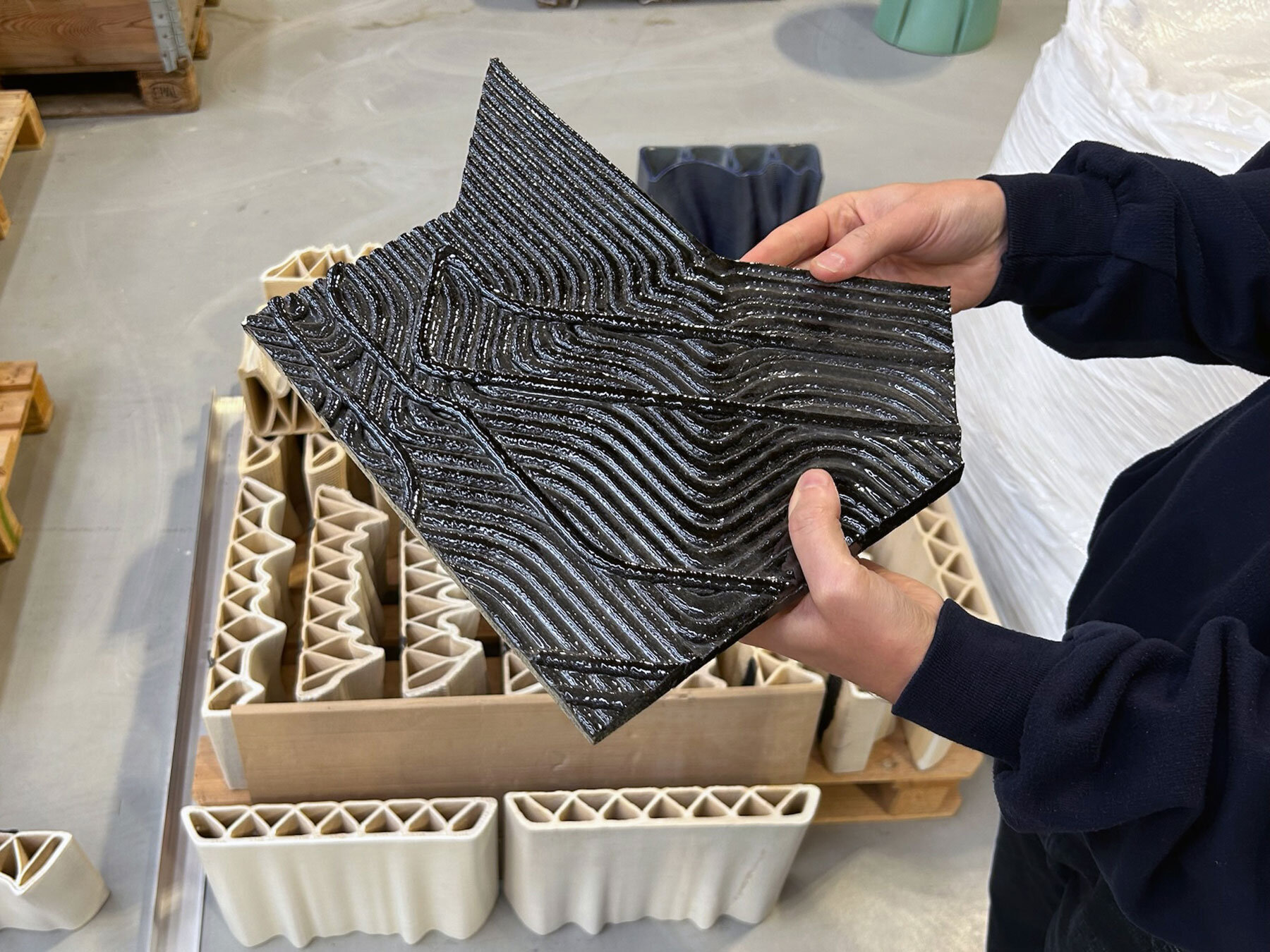
each tile is interesting on its own, and together they tell the story of the project | image © designboom
DB: Of all the projects that you have worked on, is there a specific one that stands out for you?
LH: The New Delft Blue and the Ceramic House really stand out for me. The New Delft Blue project, in particular, is striking because you can see each unique tile individually, covered in this beautiful glaze. We developed an algorithm that generated the pattern and the overall shape of the structure. We didn’t design each panel individually, which resulted in some quite interesting and sometimes surprising panels. Occasionally, they even turn out a bit weird, but there’s a beauty in those weird panels too. It’s not how we would design it ourselves, but because it was created by the computer, each panel becomes interesting in its own way. Together, all the panels form these shapes that resemble leaves growing from one side to the other. I think that’s a really nice feature of the New Delft Blue project.
It’s the same with the Ceramic House project. Each tile is interesting on its own, and together they tell the story of the project. That’s what I like about these projects—they’re also quite different. Using the same technique, we can tell many stories, but each one has its own design language. Each project has a unique design language that isn’t replicable. We’re also building a database of what’s possible and what isn’t, based on what we try in each project. The technique remains the same, but it gets refined with every new project.

studio RAP’s work challenges conventions while respecting the cultural narratives of architecture | image © designboom
DB: Does Studio RAP have a dream project that they hope to complete at some point in the future?
LH: We see a lot of potential in high-rises, like skyscrapers—not for the entire facade, but specifically for the plinth, the entrance area. For example, in New York City, many office buildings are being transformed into residential towers. These buildings often lack a familiar, homey feel; they’re a bit cold or missing a sense of identity. It would be really interesting for us to use our technique to give these towers a strong identity at and around the entrance.

‘I think clay is great for architectural ornamentation,’ notes Lucas ter Hall | image © designboom

in collaboration with the client, the studio creates a specific family of tiles to suit each project | image © designboom

studio RAP’s bespoke ceramic designs seek to tell a story | image © designboom

the ceramic tile design must be divided into smaller pieces to be manageable | image © designboom

right now, the studio doesn’t have any ambition to work with another material, besides clay | image © designboom

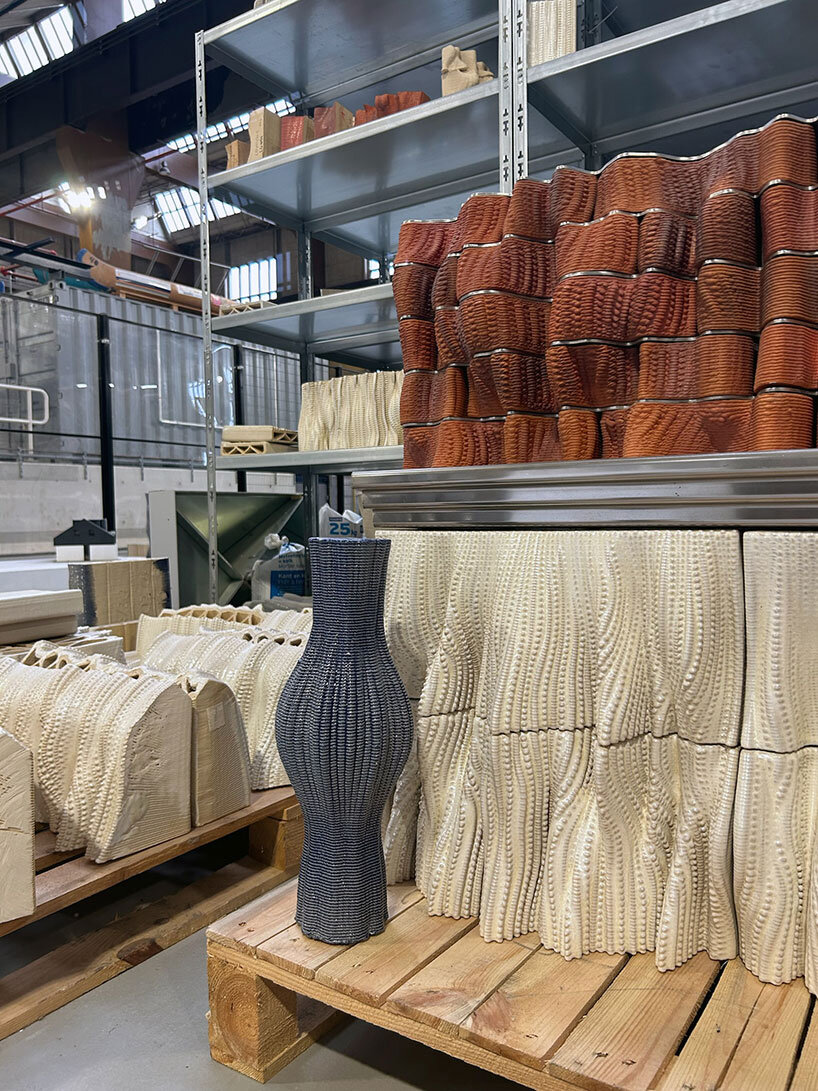


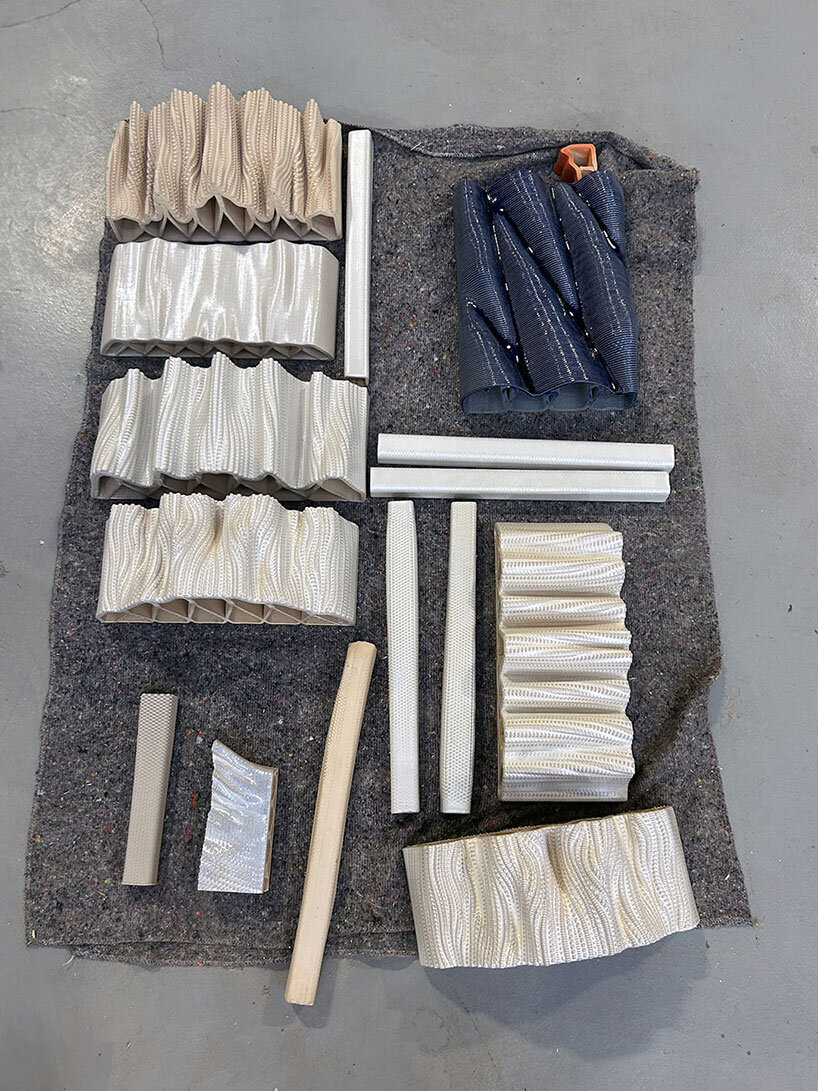

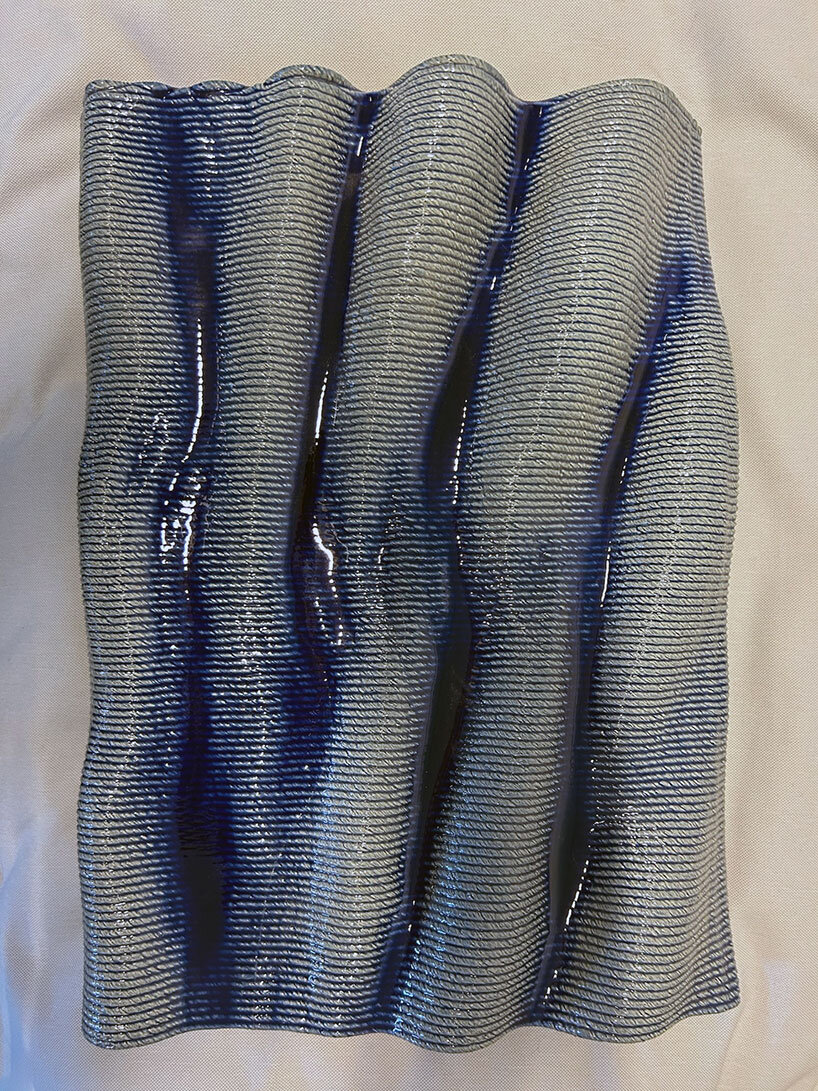
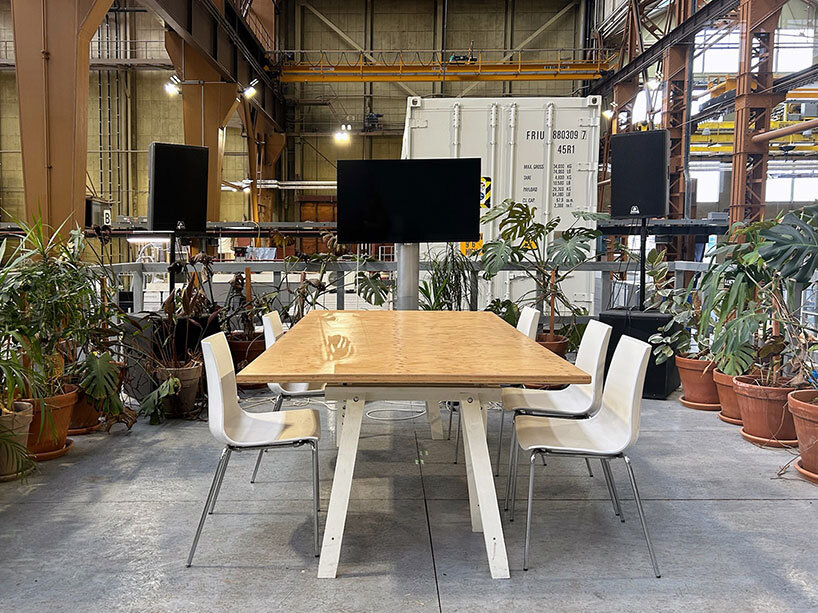
project info:
architect: Studio RAP | @studio.rap
studio location: Rotterdam, The Netherlands
happening now! partnering with antonio citterio, AXOR presents three bathroom concepts that are not merely places of function, but destinations in themselves — sanctuaries of style, context, and personal expression.













